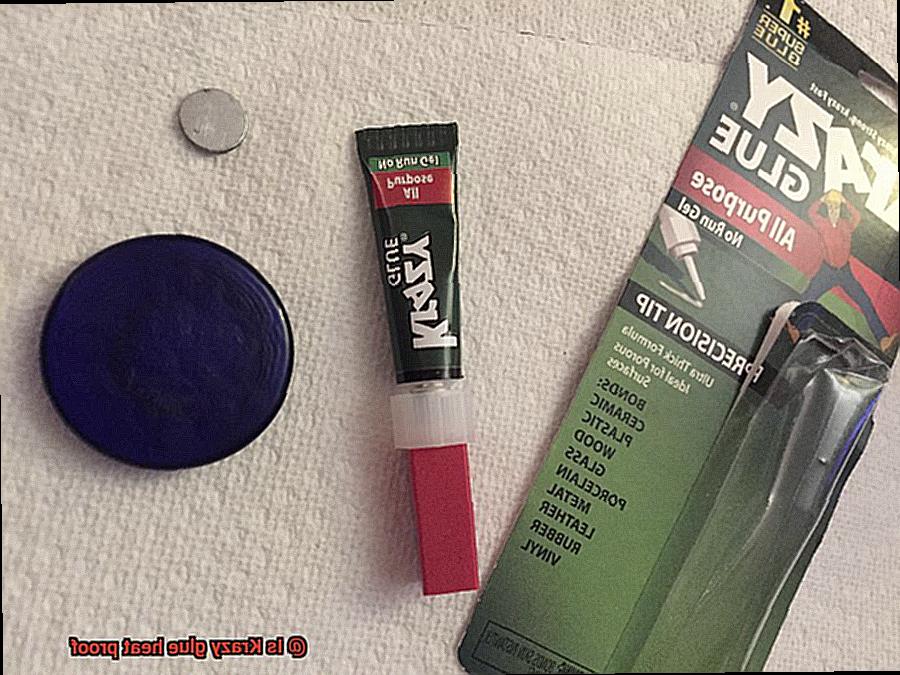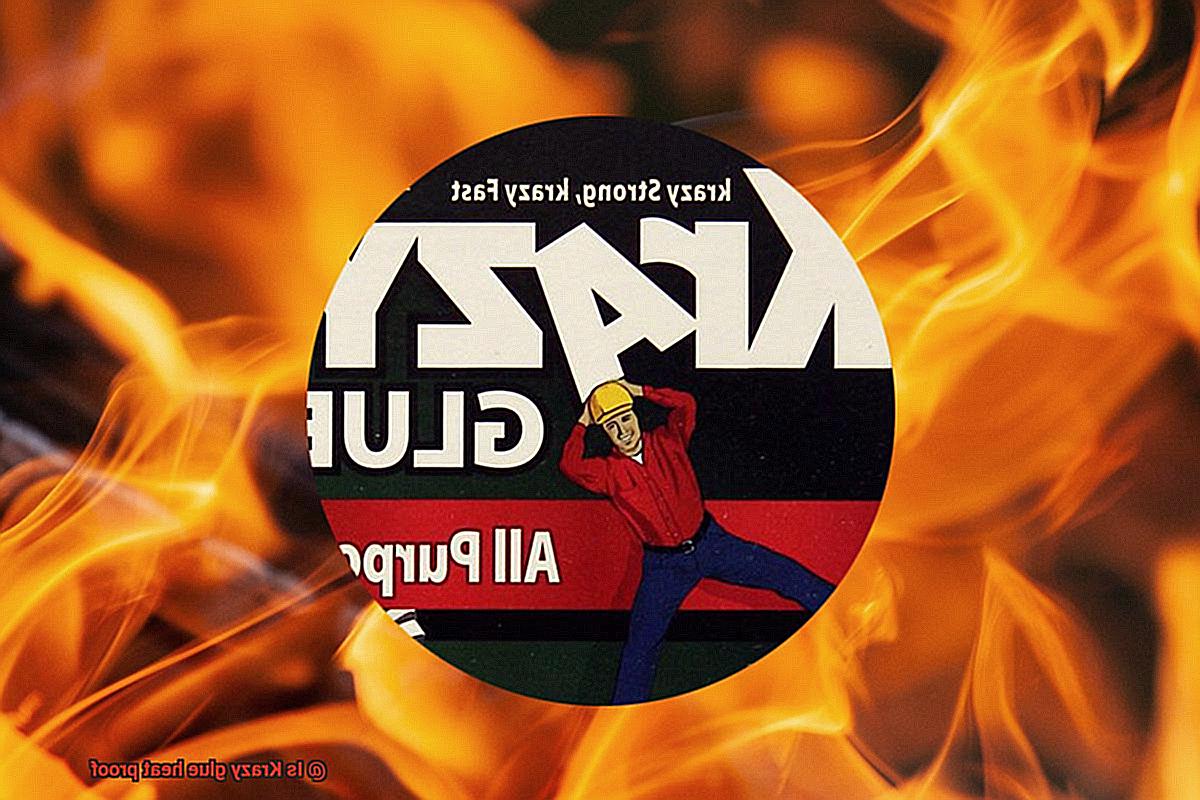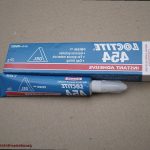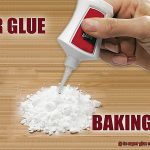Welcome, fellow crafters and DIY enthusiasts, to our blog post tackling the burning question: is Krazy Glue heatproof?
Picture this: you’re in the middle of a project, trying to fix that beloved ceramic mug or bond those stubborn metal surfaces. But here’s the catch – your creation is going to be exposed to some serious heat.
That’s where a heatproof glue comes in handy, my friend. Today, we’re going to take a deep dive into the fascinating world of Krazy Glue and put its heat-resistant properties to the ultimate test.
So, grab your favorite hot beverage, gather ’round, and let’s find out if Krazy Glue can handle the heat like a boss.
Heat Resistance of Krazy Glue
Contents
- 1 Heat Resistance of Krazy Glue
- 2 Manufacturer’s Claims About Krazy Glue and Heat
- 3 The Melting Point of Krazy Glue
- 4 Potential Hazards When Working with Krazy Glue Near Heat Sources
- 5 Applications Where Krazy Glue Should Not Be Used
- 6 Alternatives to Krazy Glue for High Temperature Applications
- 7 Safety Tips for Using Adhesives Including Krazy Glue
- 8 Conclusion
Krazy glue, also known as cyanoacrylate adhesive, is a go-to choice for its quick and secure bonding capabilities. However, understanding its limitations in terms of heat resistance is crucial. In this article, we will explore the heat resistance of Krazy glue and share valuable tips to ensure safe and effective application.
Understanding the Heat Limitations:
While Krazy glue boasts impressive bonding strength, it is not designed to be heatproof or withstand high temperatures. The manufacturer advises that it can tolerate temperatures up to 180°F (82°C) for short durations. Yet, it’s important to note that prolonged exposure to high temperatures may compromise the bond’s effectiveness.
Precautions for High-Temperature Applications:
- Avoid direct heat exposure: To preserve the bond’s integrity, keep Krazy glue at a safe distance from heat sources like open flames, scorching stovetops, or sizzling hot surfaces.
- Opt for specialized adhesives: If your project calls for an adhesive capable of withstanding higher temperatures, consider using specialized heat-resistant adhesives specifically formulated for such demanding applications. These adhesives feature cutting-edge materials engineered to endure much higher temperature ranges.
- Test small areas: When uncertain about Krazy glue’s heat resistance for a specific task, always conduct a preliminary test. Apply a small amount of glue to an inconspicuous area and subject it to the anticipated temperature range. This experimentation will determine whether Krazy glue is suitable or if an alternative adhesive is necessary.
- Seek guidance from professionals or the manufacturer: If unsure about Krazy glue’s suitability for your unique project, don’t hesitate to consult professionals or reach out directly to the manufacturer. Their expertise can offer tailored advice based on your specific requirements.
Manufacturer’s Claims About Krazy Glue and Heat
Today, we delve deep into the sizzling topic of Krazy Glue’s heat resistance. Can it truly withstand the scorching temperatures that the manufacturer claims? Let’s uncover the truth.
The Manufacturer’s Bold Claims:
The manufacturer of Krazy Glue boasts that their adhesive can endure temperatures up to 300 degrees Fahrenheit (149 degrees Celsius) without compromising its steadfast bond. Sounds impressive, right? But before we wholeheartedly believe these claims, let’s dissect them further.
Real-World Testing: The Crucial Experimentation
To validate the manufacturer’s assertions, we must conduct meticulous experiments under controlled conditions. Apply Krazy Glue to various materials and expose them to different levels of heat. Observe how the glue performs in each scenario – does it stand strong like an unyielding titan or start to crumble under pressure? This hands-on approach will provide invaluable insights into its heat resistance.
Consider Real-World Scenarios:
Let your imagination wander to everyday situations where Krazy Glue might come into play. Picture yourself repairing a shattered ceramic mug – you need assurance that the glue can withstand the heat generated when hot liquids are poured inside. Test the glue on a similar material and subject it to scalding water. Does it maintain its bond or buckle under the intense heat?
User Experiences:
While the manufacturer’s claims hold weight, real-life experiences from DIY enthusiasts and professionals offer valuable anecdotes. Seek out wisdom from those who have put Krazy Glue’s heat resistance to the test in their own projects. Their stories shed light on how this adhesive performs in different heat-related scenarios, adding depth to our understanding.
Safety Precautions:
Keep in mind that Krazy Glue does have limitations when it comes to heat resistance. The manufacturer advises caution, recommending that temperatures stay below 180°F (82°C) for short periods to avoid compromising the bond. If your project demands a higher temperature tolerance, explore specialized adhesives tailored for high-heat applications.
While Krazy Glue may not be impervious to searing temperatures, it remains a dependable adhesive for a wide range of projects.
By conducting controlled experiments and gathering insights from experienced users, you can confidently navigate its heat resistance capabilities.
And remember, when in doubt, consult professionals or reach out directly to the manufacturer for personalized advice.
The Melting Point of Krazy Glue
Today, we embark on an exploration of the melting point of Krazy Glue and its significance in high-temperature applications.
Krazy Glue, renowned for its impeccable bonding capabilities, has won the hearts of many.
But can it withstand the unforgiving heat of demanding environments? Let us unravel this mystery.
Understanding the Melting Point:
Krazy Glue belongs to the family of cyanoacrylate adhesives, which solidify through a process called polymerization. The melting point of Krazy Glue may vary depending on its specific formulation and brand. In general, it lies within the range of 80°C (176°F) to 120°C (248°F).
Implications for High-Temperature Applications:
While Krazy Glue may not lose its adhesive properties completely below its melting point, it is not recommended for use in high-temperature environments. When subjected to excessive heat, it can gradually soften and potentially melt, compromising the strength of its bonds or even causing them to fail.
Manufacturer’s Guidelines:
To ensure optimal performance, it is crucial to consult the manufacturer’s guidelines and recommendations when using Krazy Glue in specific temperature conditions. These guidelines provide valuable insights into the adhesive’s limitations and can help prevent unforeseen consequences.
Alternatives for High-Temperature Applications:
If your project demands an adhesive capable of withstanding high temperatures, consider exploring specialized heat-resistant adhesives. These adhesives are intricately formulated to maintain their strength and integrity under extreme heat conditions, guaranteeing resilient and long-lasting bonds.
Conclusion:
Krazy Glue undeniably possesses remarkable bonding capabilities; however, its melting point reveals that it has limited resistance to heat. In high-temperature applications, it is advisable to opt for alternatives specifically engineered to endure extreme temperatures. Remember, comprehending the capabilities and limitations of adhesives is vital for successful and enduring bonds in any project.
Potential Hazards When Working with Krazy Glue Near Heat Sources

When working with Krazy Glue near heat sources, there are several potential hazards that you need to be aware of. The first and most important hazard is the release of toxic fumes. Krazy Glue contains a compound called cyanoacrylate, which can emit fumes when exposed to heat. These fumes can be highly irritating to your respiratory system and can leave you feeling dizzy or nauseous. To avoid exposure, it is crucial to work in a well-ventilated area to minimize the inhalation of these toxic fumes.
Another significant hazard is the flammability of Krazy Glue. This adhesive is highly flammable and can ignite when exposed to heat or an open flame. This poses a potentially dangerous situation, especially if you are working near something flammable. It is essential to keep Krazy Glue far away from any open flames or sparks to prevent unexpected fires from breaking out.
In addition to the release of toxic fumes and the risk of fire, heat can also affect the performance of Krazy Glue. Excessive heat can weaken the bond created by the glue, making it less secure and reliable. If you are relying on Krazy Glue to hold something together, excessive heat may compromise its effectiveness.
To minimize these hazards, it is important to take certain precautions. Firstly, always ensure that you work in a well-ventilated area to reduce exposure to toxic fumes. This will help protect your respiratory system from any potential harm. Secondly, store Krazy Glue in a cool and dry place, away from any heat sources. Storing it near heat sources can cause it to deteriorate or lose its effectiveness over time.
If you accidentally expose Krazy Glue to heat, such as placing a hot object on a surface bonded with the glue, it is crucial to let the glue cool down before attempting to separate the objects. Trying to force them apart while the glue is still hot can result in injury.
In the unfortunate event of a fire caused by Krazy Glue, it is essential to use appropriate fire-fighting methods to extinguish the flames. Your safety should always be your top priority.
Applications Where Krazy Glue Should Not Be Used
Krazy Glue, the mighty adhesive that can work wonders in many situations, does have its limitations. To ensure your projects turn out perfectly, it’s important to know where Krazy Glue should not be used. Let’s explore these applications in more detail.
- High Temperatures: Krazy Glue is not a fan of heat. Avoid bonding near open flames, cooking appliances, or scorching sunlight. This adhesive can lose its adhesive properties when exposed to high temperatures, and you definitely don’t want your hard work going up in smoke.
- Flammability: Krazy Glue is flammable, so keep it away from sparks and flames. Safety first. Always store this adhesive away from heat sources to prevent any fiery mishaps.
- Challenging Materials: Some materials can put up a tough fight against Krazy Glue. Plastics like polyethylene and polypropylene have low surface energy, making it difficult for adhesives to form a strong bond. Smooth or non-porous metals like aluminum may also not be the best match.
- Lack of Flexibility: Krazy Glue is rigid once cured, so if you need a joint or area that experiences frequent bending or twisting, it might not be the right choice. We don’t want any broken bonds.
- Temperature Fluctuations: If your project will be exposed to varying temperatures, be cautious. The expansion and contraction of materials due to temperature changes can strain the adhesive bond over time. Consider using a different adhesive in these situations.
Alternatives to Krazy Glue for High Temperature Applications
We all know and adore Krazy Glue for its super strength and lightning-fast drying time. But did you know that when it comes to heat, this adhesive champion starts to lose its powers? Fear not, my friends, because I’m here to introduce you to some alternative adhesives that can handle the heat like nobody’s business.
First up on our list of heat-resistant heroes is the mighty epoxy resin. These bad boys are renowned for their excellent heat resistance, with some products capable of withstanding temperatures up to a scorching 300°F or even higher. They’re like the superheroes of the adhesive world, forming a bond so strong it can withstand the toughest conditions. It’s no wonder they’re favored in industries like automotive, aerospace, and electronics.
- But let’s not forget about our trusty sidekick – cyanoacrylate adhesive, also known as super glue. While it may not possess the same heat resistance as epoxy or silicone adhesives, it can still hold its own in temperatures up to a sizzling 150°C. Just be sure to check the heat resistance capabilities of the specific product before getting carried away.
- Now, let’s talk about silicone adhesives – these babies are the epitome of thermal stability. With the ability to handle temperatures ranging from an icy -50°C all the way up to a scorching 200°C or higher, they’re perfect for sealing and bonding applications where high temperature resistance is an absolute must.
But what about those extreme high temperature applications that make your head spin and your glue melt? Well, my friends, that’s where ceramic-based adhesives and specialty high-temperature epoxies step in. These specially formulated adhesives are designed to handle temperatures exceeding a mind-boggling 500°C. Talk about some serious firepower.
Before you rush off to purchase your new heat-resistant adhesive, keep in mind that different adhesives have different requirements. Factors like substrate material, curing time, and application method should be carefully considered. Some adhesives may require specific surface preparations or longer curing times to reach their full potential. So, take the time to do your research and select the adhesive that best suits your specific needs.
Safety Tips for Using Adhesives Including Krazy Glue
Adhesives, such as Krazy Glue, are incredibly useful for a wide range of projects and repairs. However, it’s essential to prioritize safety when working with these powerful bonding agents. In this article, we will explore some vital safety tips to keep in mind when using adhesives, including Krazy Glue.
Read and Follow Instructions:
Every adhesive has its own unique set of guidelines and precautions provided by the manufacturer. It’s crucial to read and follow these instructions before using any adhesive, ensuring optimal results and safety.
Work in a Well-Ventilated Area:
Certain adhesives, including Krazy Glue, can release harmful fumes. To protect yourself from inhaling these potentially dangerous substances, always work in a well-ventilated area. Open windows or use a fan to ensure fresh air circulation while you work.
Protect Your Skin and Eyes:
When working with adhesives, particularly Krazy Glue, it’s vital to shield your skin and eyes from accidental contact. Wear gloves and safety glasses to prevent any adhesive from coming into contact with your skin or eyes. If contact does occur, rinse immediately with water and seek medical attention if necessary.
Keep Adhesives Out of Reach:
Adhesives should always be stored out of reach of children and pets. Accidental ingestion can lead to harm or injury, so store adhesives securely in a location that cannot be accessed by curious hands or paws.
Avoid Flames and Heat Sources:
Some adhesives are highly flammable and can ignite when exposed to open flames or high temperatures. It’s crucial to work in a safe area away from potential ignition sources like stoves or heaters to prevent accidents or fires.
Proper Storage and Disposal:
To maintain the effectiveness of adhesives, store them in a cool, dry place away from direct sunlight. When disposing of empty adhesive containers, follow local regulations. If a container still contains adhesive or dried glue residue, it may be considered hazardous waste and require special disposal methods.
A15EjGks83Q” >
Also Read: Krazy Glue – Glue Things
Conclusion
In conclusion, while Krazy Glue is a dependable adhesive for various projects, its ability to withstand heat has its boundaries. The manufacturer advises that it can handle temperatures up to 180°F (82°C) for brief periods, but extended exposure to high temperatures may compromise the effectiveness of the bond. Therefore, it is crucial to exercise caution when using Krazy Glue in applications involving elevated temperatures.
If your project demands an adhesive that can endure higher temperatures, consider utilizing specialized heat-resistant adhesives specifically designed for such demanding tasks. These adhesives are engineered to withstand much wider temperature ranges and offer more reliable bonding even in extreme conditions.
To ensure Krazy Glue’s suitability for a specific task where heat resistance is a concern, it is always recommended to conduct a preliminary test. Apply a small amount of glue to an inconspicuous area and subject it to the anticipated temperature range. This experimentation will determine whether Krazy Glue is suitable or if an alternative adhesive should be considered.
Moreover, seeking guidance from professionals or directly contacting the manufacturer can provide personalized advice based on your unique requirements.
Keep in mind that working with adhesives near heat sources can pose potential hazards such as toxic fumes, flammability, and compromised performance. It is crucial to work in well-ventilated areas, store adhesives away from heat sources, and adhere to safety guidelines provided by the manufacturer.
Ultimately, comprehending the capabilities and limitations of adhesives like Krazy Glue is essential for achieving successful and long-lasting bonds in any project.






